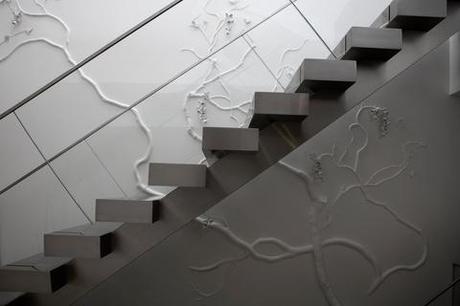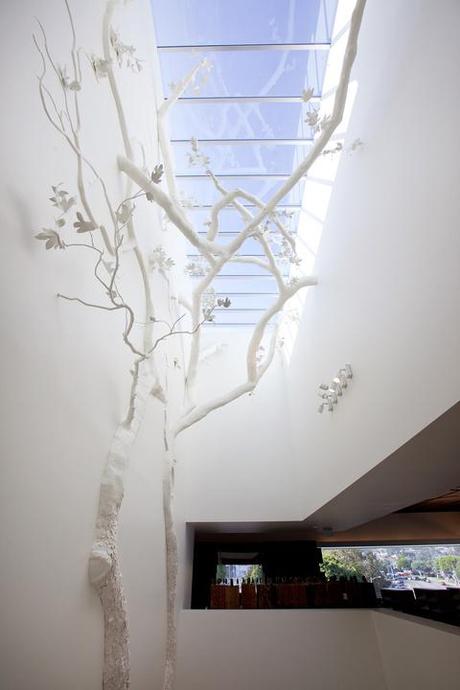
Upon the revelation that a clients’ last names meant Wisteria in Japanese and Linden tree in German, Wiseman set to work creating an intertwined combination of the two plants stretching across four floors of the family’s home. An owl was later added to signify the couple’s son. Installation in a New York residence; Wisteria and Linden motif. Photo by: Sherry Griffin/R 20th Century.
For a young artist, commissioned work can nurture and shape their potential career, allowing them the means to explore new methods and materials. While it is common practice for artists and designers to produce works in collaboration with manufacturers, the practice of personal commissions seems to belong to eras past. Unless you’ve commissioned a work of art yourself, today the mysterious process is rarely discussed in detail. Wiseman and Meyer’s insight to the process of patronage helped uncover some of that mystery.
From an early point in his career, Wiseman found inspiration in nature. Moved by fallen trees he found “too precious not to haul back to [his] studio,” he decided to create pieces that brought nature indoors. These manifested in the form of 3-dimensional wall ornaments he dubbed ‘wall forests.’ Rodman Primack, an interior designer and champion of this early work, approached Wiseman with a proposal to extrapolate the small pieces into a larger work to cover a client’s ceiling. And so the first of many commissions was born.
Slideshow
The Platanus bibliotechalis installation at the West Hollywood Library took cues from Sycamore trees in a nearby park. Faced with a short deadline for the commission, Wiseman chose to integrate the challenge into his design rather than let it live as a concession in the process. Photo by: Mark Hanauer.
For artist David Wiseman, commissioned work has proven a rewarding way to create. He isn’t interested in repeating previous works and takes an old world approach to commissions—creating pieces that are not only site specific, but carry significant meaning to the client. He immerses himself with patrons to learn their history and character and is emphatic that while they need not have a specific vision, they must be excited. Through client interaction and visits to the site he finds creative direction. Many of the final pieces are so tied to the clients they could be likened to a modern day version of the family crest. He describes the process as collaborative though he is clear that he has set parameters that prevent him from compromising his artistic integrity.
As patronage has become integral to his career, it’s no wonder he used a fictitious client as inspiration for his first solo show with R 20th Century (curated by Rodman Primack). A dining table tableau created for the imaginary client incorporated features from his past work and commissions. Wiseman enjoys the process of creating “something for somebody,” finding work arbitrary otherwise; a reason patronage may be a natural fit for his career.
Information on future discussions and programs taking part at MAD during the Home Front 2013 can be found here.
